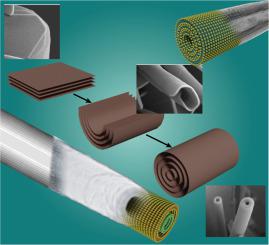Nano Today ( IF 17.4 ) Pub Date : 2020-12-24 , DOI: 10.1016/j.nantod.2020.101060 Sudarson S. Sinha , M.B. Sreedhara , Reshef Tenne

|
Analyzing naturally occurring layered alumo(magnesium)silicates (asbestos) minerals, Pauling proposed in 1930 that the strain in compounds with asymmetric structure, like kaolinite (hallyosite), lends itself for folding of the layers. Once transmission electron microscopy gained sufficient resolution in 1950, chrysotile and hallyosites nanotubes were discovered fully confirming this early hypothesis. Following the discovery of carbon fullerene (C60) by Kroto and Smalley and carbon nanotubes by Iijima, Tenne proposed a new mechanism for the formation of nanotubes from inorganic compounds with layered structure via seaming of their chemically reactive rims. Early on, nanotubes of WS2 and subsequently MoS2, GaSe and BN were found experimentally and in silico and many others followed over the years. Here, different mechanisms for the formation of nanotubes from inorganic compounds with layered structure are analyzed with a few examples. Few potential applications of such nanotubes are briefly discussed, as well. Finally, several frontiers and scientific challenges in this field in the years ahead are presented
中文翻译:

为什么2D材料的纳米晶体形成纳米管,为什么如此重要?
鲍林在1930年提出对天然存在的层状铝(镁)硅酸盐(石棉)矿物进行分析后,提出具有不对称结构的化合物(如高岭石(铁矾石))的应变可使其折叠。1950年,一旦透射电子显微镜获得了足够的分辨率,就发现了温石棉和埃洛石纳米管,充分证实了这一早期假设。继Kroto和Smalley发现碳富勒烯(C 60)和Iijima发现碳纳米管之后,Tenne提出了一种新的机理,即通过具有化学反应性边缘的接缝,由具有分层结构的无机化合物形成纳米管。早期,通过实验发现了WS 2的纳米管,随后发现了MoS 2,GaSe和BN。这些年来,在计算机上进行了跟踪。在此,通过几个例子分析了由具有层状结构的无机化合物形成纳米管的不同机理。还简要讨论了这种纳米管的潜在应用。最后,介绍了未来几年该领域的一些前沿领域和科学挑战


























 京公网安备 11010802027423号
京公网安备 11010802027423号